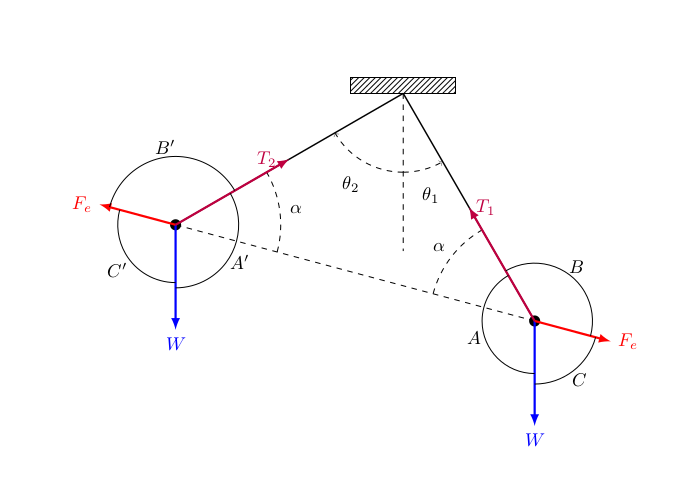2 identical pendulums A&B are suspended from same point.The bobs A&B are given positive charges q1 and q2 (q1<q2). If A&B are making angles $1 and $2 with the vertical and T1 and T2 are tensions in the string respectively.Then prove that $1=$2 and T1=T2?
2 Answers
This is usually considered to be "obvious" from the symmetry of the problem. It turns out that proving this directly is not entirely trivial - see below.
Explanation:
From the diagram :

it is obvious (since the two pendulums are identical) that
It is also quite easy to work out that
and
We can arrive at the final proof most readily by means of Lamé's theorem (https://en.wikipedia.org/wiki/Lami%27s_theorem), which states that
When three forces are in equilibrium, their magnitudes are proportional to the sine of the angle between the other two.
(This is a simple consequence of the sine law for triangles)
Thus
Note that the two masses are identical, and the magnitudes of Coulomb repulsion acting on the two charges are the same.
These ratios can be rewritten as
and
So, obviously
Another way of proving this result is by using energy considerations. I will use the same diagram and conventions used in my previous answer https://socratic.org/s/aQbwm9py
Explanation:
In equilibrium, the total potential energy of the system will be the least possible. Note that this consists of the electrostatic potential energy of the charges and the gravitational potential energy - tension, being a no-work force, does not contribute. Of these, the first term depends on the distance between the two charges - and this in turn depends only on the angle
This means that in equilibrium, the angles
(here we have taken the gravitational potential energy )will be the least subject to a constant value of
This implies that in equilibrium
so for this to be maximum at a fixed value of
Note
Minimizing the total potential energy (electrostatic+gravitational) with respect to the common value

